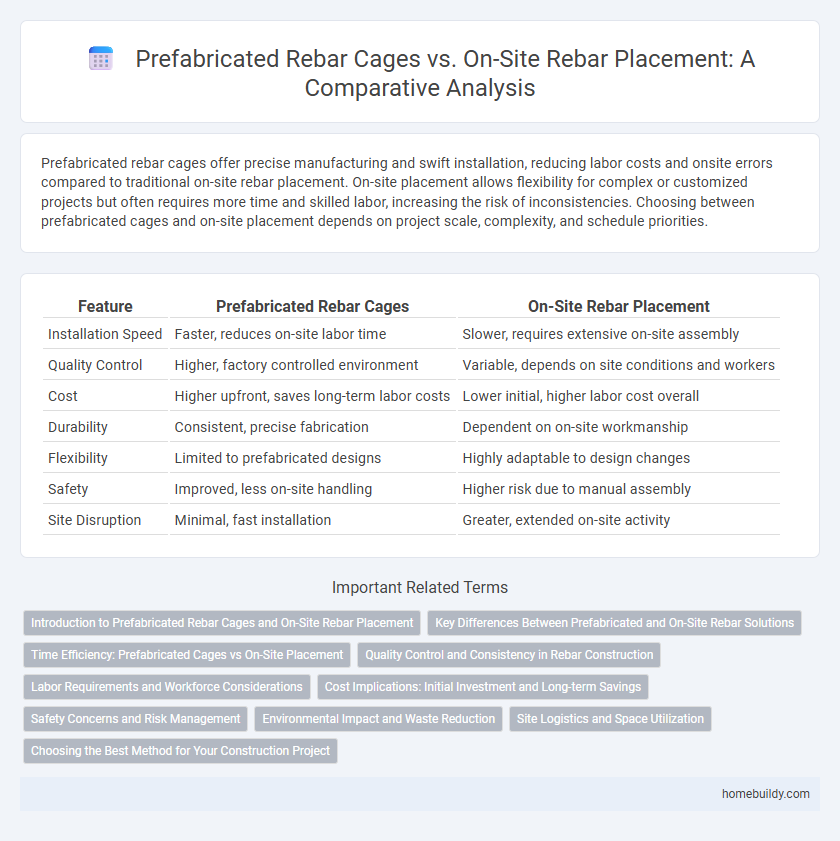Prefabricated rebar cages offer precise manufacturing and swift installation, reducing labor costs and onsite errors compared to traditional on-site rebar placement. On-site placement allows flexibility for complex or customized projects but often requires more time and skilled labor, increasing the risk of inconsistencies. Choosing between prefabricated cages and on-site placement depends on project scale, complexity, and schedule priorities.
Table of Comparison
| Feature | Prefabricated Rebar Cages | On-Site Rebar Placement |
|---|---|---|
| Installation Speed | Faster, reduces on-site labor time | Slower, requires extensive on-site assembly |
| Quality Control | Higher, factory controlled environment | Variable, depends on site conditions and workers |
| Cost | Higher upfront, saves long-term labor costs | Lower initial, higher labor cost overall |
| Durability | Consistent, precise fabrication | Dependent on on-site workmanship |
| Flexibility | Limited to prefabricated designs | Highly adaptable to design changes |
| Safety | Improved, less on-site handling | Higher risk due to manual assembly |
| Site Disruption | Minimal, fast installation | Greater, extended on-site activity |
Introduction to Prefabricated Rebar Cages and On-Site Rebar Placement
Prefabricated rebar cages are pre-assembled reinforcement structures manufactured in controlled environments, ensuring precise dimensions and consistent quality, which accelerates construction timelines and reduces onsite labor. On-site rebar placement involves manually cutting, bending, and tying reinforcement bars directly at the construction site, allowing for flexibility in design adjustments but often increasing labor costs and potential for errors. Comparing both methods highlights the trade-offs between factory precision and field adaptability in reinforced concrete projects.
Key Differences Between Prefabricated and On-Site Rebar Solutions
Prefabricated rebar cages offer precise dimensional accuracy and faster installation times compared to on-site rebar placement, reducing labor costs and minimizing construction delays. On-site rebar placement provides flexibility for adjustments during complex project phases, addressing specific site conditions more effectively. The choice between prefabricated and on-site rebar solutions impacts overall project efficiency, quality control, and cost management in reinforced concrete construction.
Time Efficiency: Prefabricated Cages vs On-Site Placement
Prefabricated rebar cages significantly reduce construction time by enabling simultaneous off-site fabrication and on-site preparation, minimizing project delays and labor disruptions. On-site rebar placement requires manual assembly, increasing labor hours and susceptibility to errors, which can extend construction schedules. Studies show prefabrication can cut installation time by up to 40%, enhancing overall project efficiency and cost-effectiveness.
Quality Control and Consistency in Rebar Construction
Prefabricated rebar cages offer superior quality control and consistency compared to on-site rebar placement due to factory-controlled manufacturing environments that minimize human error and ensure precise measurements. This method reduces variability in bar spacing, alignment, and welding standards, resulting in enhanced structural integrity and compliance with engineering specifications. In contrast, on-site placement is more susceptible to inconsistencies from environmental factors, labor skill levels, and real-time site adjustments that can compromise overall rebar performance.
Labor Requirements and Workforce Considerations
Prefabricated rebar cages significantly reduce labor requirements on-site by allowing specialized teams to construct cages in controlled environments, which improves accuracy and minimizes on-site errors. On-site rebar placement demands a larger, highly skilled workforce to handle complex bending and tying tasks, increasing labor costs and potential delays. Prefabrication streamlines project timelines and labor management by shifting workforce needs from the construction site to fabrication facilities.
Cost Implications: Initial Investment and Long-term Savings
Prefabricated rebar cages typically require a higher initial investment due to factory labor, precise engineering, and transportation costs, but they significantly reduce on-site labor expenses and project delays. On-site rebar placement involves lower upfront costs but can lead to increased labor hours, higher risk of errors, and potential rework, which inflate overall project expenses. Long-term savings are more pronounced with prefabricated cages thanks to enhanced durability, improved quality control, and minimized construction time.
Safety Concerns and Risk Management
Prefabricated rebar cages significantly reduce onsite safety risks by minimizing manual handling and cutting activities, which are common causes of injuries during on-site rebar placement. Factory-controlled environments ensure consistent quality and secure tying, lowering the likelihood of structural failures and rebar displacement onsite. Implementing prefabricated cages streamlines risk management by enhancing worker safety and reducing exposure to hazardous conditions typically encountered during traditional rebar installation.
Environmental Impact and Waste Reduction
Prefabricated rebar cages significantly reduce environmental impact by minimizing onsite waste and emissions through controlled factory production, optimizing material usage and cutting down transportation trips. On-site rebar placement often leads to excess waste from cutting and bending errors, increasing landfill contributions and resource inefficiencies. Utilizing prefabricated cages enhances sustainability by lowering carbon footprints and promoting circular construction practices.
Site Logistics and Space Utilization
Prefabricated rebar cages significantly reduce on-site congestion by minimizing manual cutting, bending, and tying activities, streamlining site logistics. Off-site fabrication allows precise assembly in controlled environments, optimizing labor allocation and equipment use at the construction site. This approach enhances space utilization by limiting on-site material storage and workspace requirements, leading to safer and more efficient project execution.
Choosing the Best Method for Your Construction Project
Prefabricated rebar cages offer consistent quality control, faster installation, and reduced labor costs, making them ideal for projects with tight schedules and complex designs. On-site rebar placement provides flexibility for last-minute design changes and custom adjustments, benefiting projects with unpredictable site conditions. Evaluating project size, timeline, budget, and site accessibility helps determine the optimal rebar method for structural integrity and construction efficiency.
Prefabricated Rebar Cages vs On-Site Rebar Placement Infographic

 homebuildy.com
homebuildy.com